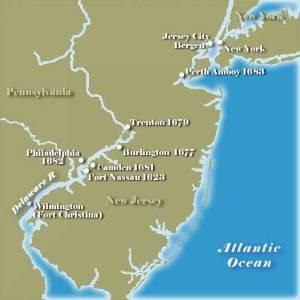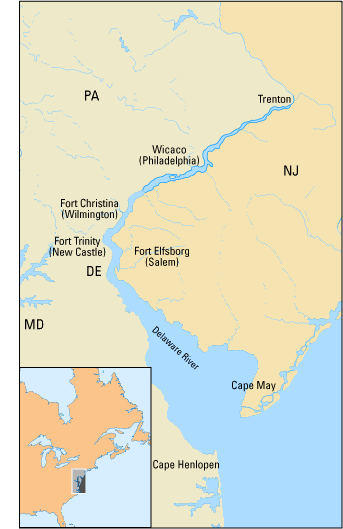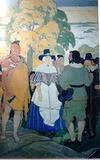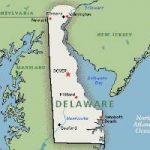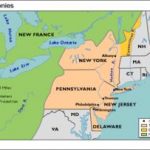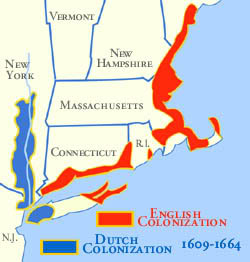The Year: 1664
Image: Map of Colonial New Jersey
The early European settlement of New Jersey involved the Dutch and the Swedes. The Dutch West India Company worked to stimulate settlement in the area by granting large tracts of land to its members in New Netherland, which included the area that would become New Jersey. These grants were called patroonships. A patroon was a landholder who was granted one of these great estates in exchange for bringing fifty new settlers into the colony.
In 1620, a trading post was established at the site of Bergen, New Jersey, which would later be developed as the first permanent white settlement in the area. Other Dutch enclaves followed at Fort Nassau and at Jersey City.
Swedish settlements began in southern New Jersey in 1638, which touched off a rivalry between the two powers over the fur trade. The Dutch under Peter Stuyvesant successfully evicted the Swedes in 1655.
The entire region was claimed by England in 1664. King Charles II granted domain to his brother James Duke of York, who granted the land between the Delaware and Hudson Rivers to two of his supporters, Lord John Berkeley and Sir George Carteret.
These enterprising businessmen offered land at bargain prices and full religious toleration to attract settlers. The name New Jersey was introduced, which honored the Isle of Jersey in the English Channel.
In 1665, Carteret began to colonize his new possessions. He sent his nephew Philip Carteret to act as governor of the first settlement at Elizabethtown, named in honor of Sir George’s wife. A large number of settlers came from New England, especially from New Haven, where the colonists had been forced to become a part of Connecticut. These Puritans founded Newark and adjacent towns.
Carteret granted a form of government known as the Concessions, which granted religious liberty to all Englishmen in the new colony and established a government to be carried on by a governor, a council, and an assembly of twelve to be chosen by the people, and no taxes were to be charged without the consent of the assembly.
A farm, free for five years, was offered to any one “having a good musket… and six months’ provisions,” who should embark with the governor, while those who came later were to pay a half-penny an acre quitrent.
The first assembly met at Elizabethtown in 1668, and the severity of the laws that were adopted clearly indicated the Puritan domination of the colony. After a session of but five days it adjourned, and met no more for seven years.
The fertility of the soil, the fair climate, and the lack of hostilities with the local Native Americans caused a rapid increase in the population and prosperity of the colony.
The first quitrents fell due in 1670, but many of the settlers refused to pay rent, claiming they had received their lands from the Indians. The people rose in rebellion, elected an illegal assembly, and called James Carteret, illegitimate son of the proprietor, to be their governor. But Sir George did not support his son, and the rebellious government collapsed.
The constant commotion between Carteret and his colony discouraged Lord Berkeley, and he sold his interest in the province to two English Quakers, John Fenwick and Edward Byllynge.
The latter soon became bankrupt, and his share passed into the hands of trustees, the most prominent of whom was William Penn – the most famous of American colony builders.
In 1676, the colony was divided into two parts: East Jersey was retained by Carteret, and West Jersey became the property of the Quakers. The first important settlement in West Jersey was made in 1677, when 230 people sailed up the Delaware River and founded Burlington, and within two years several hundred more had made their homes in the vicinity.
Two wholly separate governments were set up, and they were as different as white from black. The stern New England Puritans in East Jersey passed laws with strict controls, thirteen of which were punishable by death. In West Jersey the government was exceedingly mild, and their laws gave all power to the people, and made no mention of capital punishment.
When Edmund Andros was governor of New York, in the later 1670s, he claimed authority over the Jerseys also, as the property of the Duke of York. He arrested and imprisoned Governor Philip Carteret of East Jersey, but the courts decided against Andros, and the Jerseys continued their own separate existence.
In 1680, George Carteret died, and two years later East Jersey was sold at auction to twelve men, one of whom was William Penn. Each of these twelve men sold half his interest to another man, and thus East Jersey came to have twenty-four proprietors, and they chose Robert Barclay, a Scotch Quaker, governor for life.
In 1702, the rights to both Jerseys were surrendered to the English Crown, who united the inhabitants under a royal governor, but ownership of the land remained with the previous entities. The governor of New York also served as the governor of New Jersey until 1738, when Lewis Morris became governor of New Jersey.
SOURCES
New Jersey
New Jersey State History
Settlement of New Jersey
New Jersey Colonial History
A Short History of New Jersey
